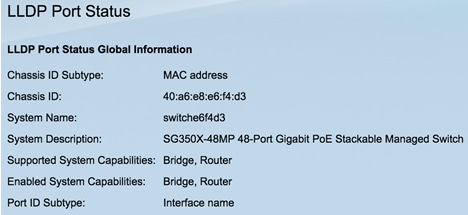View Link Layer Discovery Protocol (LLDP) Port Status Information on a Switch
Available Languages
Objective
Link Layer Discovery Protocol (LLDP) Media Endpoint Discovery (MED) provides additional capabilities to support media endpoint devices such as to enable the advertisement of network polices for applications like voice or video, device location discovery, and troubleshooting information. LLDP and Cisco Discovery Protocol (CDP) are both similar protocols, and the difference is that LLDP facilitates vendor interoperability and CDP is Cisco proprietary. LLDP can be used in scenarios where the user needs to work between devices which are not Cisco proprietary and devices which are Cisco proprietary.
The LLDP protocol is useful to network administrators for troubleshooting purposes. The switch gives all the information about the current LLDP status of ports. The network administrator can use this information to fix connectivity problems within the network.
Note: To know how to configure LLDP properties on a switch, click here for instructions.
This article provides instructions on how to view the LLDP port status information on a switch.
Applicable Devices
- Sx250 Series
- Sx300 Series
- Sx350 Series
- SG350X Series
- Sx500 Series
- Sx550X Series
Software Version
- 1.4.7.05 — Sx300, Sx500
- 2.2.8.04 — Sx250, Sx350, SG350X, Sx550X
View LLDP Port Status Information
Step 1. Access the web-based utility of the switch then choose Administration > Discover – LLDP > LLDP Port Status.

LLDP Port Status Global Information
The following information will be displayed:

- Chassis ID Subtype — Type of chassis ID.
Note: In this example, tie Chassis ID Subtype is MAC address.
- Chassis ID — Identifier of chassis. Where the chassis ID subtype is a Media Access Control (MAC) address, the MAC address of the device appears.
- System Name — Name of device.
- System Description — Description of the device in alpha-numeric format.
- Supported System Capabilities — Primary functions of the device, such as Bridge, Wireless Local Area Network (WLAN) Access Point (AP), or Router.
- Enabled System Capabilities — Primary enabled function or functions of the device.
- Port ID Subtype — Type of the port identifier that is shown.
LLDP Port Status Table
Step 2. Choose the desired interface type from the Interface Type drop-down list then click Go.

Note: In this example, Port of Unit 1 is chosen.
The following information will be displayed:

- Interface — Port identifier.
- LLDP Status — LLDP publishing option.
- LLDP MED Status — Enabled or disabled.
- Local PoE (Power Type, Power Source, Power Priority, Power Value) — Local Power over Ethernet (PoE) information advertised.
- Remote PoE (Power Type, Power Source, Power Priority, Power Value) — PoE information advertised by the neighbor.
- # of neighbors — Number of neighbors discovered.
- Neighbor Capability of 1st Device — Displays the primary functions of the neighbor; for example: Bridge or Router.
Step 3. (Optional) Click the LLDP Local Information Detail button to view the LLDP Local Information. To learn more about this feature, click here for instructions.

Step 4. (Optional) Click the LLDP Neighbor Information Detailbutton to view the LLDP Local Information. To learn more about this feature, click here for instructions.

You should now have viewed the port status information on your switch.
Revision History
| Revision | Publish Date | Comments |
|---|---|---|
1.0 |
10-Dec-2018 |
Initial Release |
 Feedback
Feedback